2003
Hydrogen Fuel Cars 2003
In 2003, hydrogen cars saw much development as both Nissan and Toyota rolled out a couple of models before the public. In addition, a rare Russian fuel cell vehicle was shown in Moscow and Folkscenter showed off their Ford Focus.
2003
 |
The 2003 Nissan X-Trail FCV uses a PEM fuel cell developed by UTC Fuel Cells unlike the 2005 Nissan X-Trail FCV whereas the fuel cell was developed in-house. The 2003 Nissan X-Trail FCV uses an E-drivetrain and 5,000 psi compressed hydrogen tanks. |
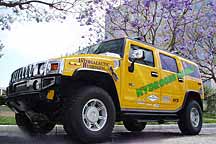 |
The 2003 Intergalactic H2 Hummer was developed by W. Fred Robinson and Tai W. Robinson, founder and CEO respectively. The Intergalactic H2 Hummer was first shown at the 2003 Los Angeles International Auto Show, when the convention was still being held in January that year. The Intergalactic H2 Hummer used a modified General Motors Vortec V8 internal combustion engine. |
 |
The 2003 Fiat Seicento Hydrogen uses a PEM fuel cell stack with an output of 40 kw. The Fiat Seicento Hydrogen also features a dynamic compressor and low noise reduction. Coming in first in its category in a race in 2005 sponsored by the Montecarlo Automobile Club, the Fiat Seicento Hydrogen beat out other fuel cell vehicles on a mixed roadway track of 250 miles. |
 |
The 2003 Mitsubishi Grandis FCV minivan used a 68 kw Ballard Mk 902 fuel cell stack. The Mitsubishi Grandis FCV was developed with DaimlerChrysler Japan Co., Ltd., and employs a 65 kw electric motor with 210 Nn of torque. |
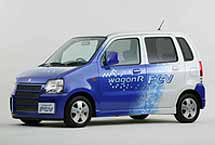 |
The 2003 Suzuki WagonR FCV has a 35 MPa storage rating for its two compressed hydrogen tanks. The 2003 Suzuki WagonR FCV contains a 50 kw fuel cell developed by General Motors and was first shown at the 2003 Tokyo Motor Show. |
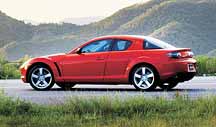 |
The 2003 Mazda RX-8 Renesis (RE) is a dual-fuel rotary engine vehicle able to use both gasoline or hydrogen at the flip of a switch. The rotary engine in the Mazda RX-8 Renesis is not prone to misfiring or backfiring as are most standard internal combustion engines. |
 |
The 2003 Toyota Fine-N hybrid electric fuel cell vehicle is a concept car that combines all-wheel electric motors and a range of 311 miles. The Toyota Fine-N is based upon the Toyota Fine-S, which was unveiled at the Detroit Auto Show. Stylish and futuristic looking the Toyota Fine-N use drive-by-wire and lithium-ion battery technology. |
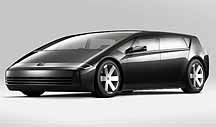 |
The 2003 Honda Kiwami (which means “ultimate” in Japanese) made its debut at the 2003 Tokyo Motor Show. The low center of gravity and bullet-like styling make this fuel cell vehicle not only a visual wonder but a performance wonder as well with its 4WD and use of ultracapacitors for added oomph. |
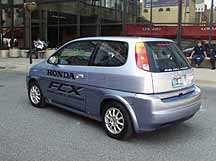 |
The 2003 Honda FCX has a range of 170 miles and a top speed of 93 mph. The 2003 Honda FCX also uses a Ballard PEM 78 kw fuel cell, a 5,000 psi gaseous hydrogen tank and can create 272 Nm of torque. |
 |
The 2003 Nissan Effis compact commuter fuel cell car uses a Super Motor design to distribute power independently to right and left wheels, enhancing stability and performance. The fuel cell stack and lithium-ion batteries of the Nissan Effis are sandwiched underneath the floor. |
 |
The 2003 BMW 7-Series V12 hydrogen automobile is a dual-fuel vehicle using either hydrogen or gasoline to power the luxury car. The 2003 BMW 7-Series V12 hydrogen uses liquid hydrogen for fuel at minus 473-degrees F and the engine was first unveiled at the 2003 Frankfort Motor Show. |
 |
The 2003 Avtovaz Lada Antel-2 is a Russian-made fuel cell vehicle first shown at the 2003 Moscow Auto Show. The Avtovaz Lada Antel-2 also used nicke-metal hydride (NiMH) batteries and compressed hydrogen to power the station wagon. |
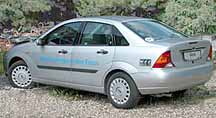 |
The 2003 Folkecenter Ford Focus is a standard 2-liter Ford Focus that was converted to run on hydrogen gas. The internal combustion engine of the Danish Folkecenter Ford Focus burns cleanly with 10 times less cost than a comparable car using a fuel cell. The car is unique in that it is dual-fuel and starts up using gasoline, then switches over at the appropriate revolutions per minute to hydrogen. |
 |
The 2003 Hyundai FCV is unique in that it contains a reformer that uses methanol, a liquid, and water to create hydrogen, which then is run through its fuel cell to power the vehicle. The onboard reformer of the 2003 Hyundai FCV is a novel idea in that it solves a key infrastructure issue in that methanol, as a liquid, is much easier to transport than gaseous hydrogen. |
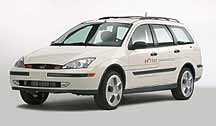 |
The 2003 Ford H2RV uses an internal combustion engine, boosted by a supercharger to run on compressed hydrogen gas. The 2003 Ford H2RV also uses a Modular Hybrid Transmission System (MHTS) and is based upon the Ford Focus wagon. |
 |
The Toyota Fine-S made its debut on January 7, 2003 at the 2003 North American International Auto Show in Detroit, Michigan. With a futuristic design, the Toyota Fine-S is a fuel cell vehicle, which supplies power to all four wheels, has a long wheel base and added road stability. |
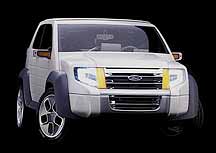 |
The Ford Model U utilizes a uniquely supercharged hydrogen-powered internal combustion engine coupled with a hybrid electric transmission. Inspired by the Model T, the Ford Model U SUV addresses a new universe in auto making including a focus on environment, emissions and use of green materials in manufacturing. The Ford Model U also includes a conversational speech interface to operate onboard systems. |
Navigation
1807-1986 1990-1998 1999 2000 2001 2002 2003 2004 2005
2006-2007 2008-2009 2010-2011 2012-2013 2014-2015 2016-2017
Written by Hydro Kevin Kantola
Leave a Reply
You must be logged in to post a comment.